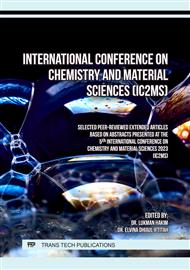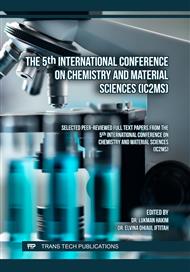p.3
p.13
p.23
p.33
p.45
p.55
p.61
Biotransformation of Isoeugenol Into Vanillin and its Derivatives Using Pseudomonas aeruginosa as an Enzyme Biocatalyst Agent: Effect of Substrate Concentration and Incubation Time
Abstract:
Isoeugenol (2-methoxy-4-[(E)-prop-1-enyl] phenol) is a compound resulting from the isomerization of eugenol contained in clove oil (Syzygium aromaticum). Isoeugenol can be used as a precursor for vanillin biosynthesis through the biotransformation pathway. In this research, the biotransformation of isoeugenol was carried out using Pseudomonas aeruginosa as an enzyme- biocatalyst agent. The parameters used in this research include the effect of substrate concentrations of 0.5; 1; 1.5; and 2% v/v, incubation times of 24; 48; 72; and 96 hours, as well as extracting solvents with ethyl acetate and chloroform. The determination of substrate concentration was carried out at an incubation time of 24 hours, and then the characterization results with the best product concentration were used to determine the incubation time. The results of qualitative identification and characterization show that with increasing the substrate concentration, it can cause decreasing the target biotransformation results. The 1% concentration treatment with the most concentrated magenta-purple color intensity from the Schiff reagent test and the most concentrated intensity of the TLC stain has more potential to produce vanillin products with an area of 0.51% (ethyl acetate) and 0.36% (chloroform), as well as vanillyl methyl ketone with an area of 1.38% (ethyl acetate) and 4.91% (chloroform). On the other hand, increasing the incubation time can reduce the target biotransformation product. The 72 hours incubation time treatment produced vanillin 0.19% (ethyl acetate) and 0.74 (chloroform), as well as vanillyl methyl ketone 1.96% (ethyl acetate), and no vanillyl methyl ketone was produced in the chloroform solvent. In the biotransformation carried out, the substrate concentration was 1% and the incubation time was 24 hours in the chloroform extracting solvent, which became a more potential condition to produce the target biotransformation product with a substrate conversion of 5.27%, which was selective for vanillyl methyl ketone at 93.17% and vanillin at 6.83%.
Info:
Periodical:
Pages:
33-42
Citation:
Online since:
July 2024
Keywords:
Price:
Сopyright:
© 2024 Trans Tech Publications Ltd. All Rights Reserved
Share:
Citation:



